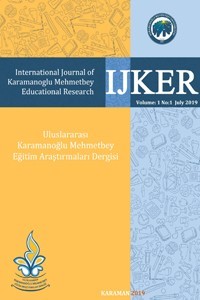Öğrencilerin Değişim Oranına İlişkin Düşünme Yolları
Değişim oranı, fonksiyonların anlaşılmasında önemli bir konudur. Aslında değişim oranı da bir fonksiyon gibi düşünülebilir. Çünkü bir niceliğin diğerine göre değişim oranı hakkında muhakeme etmek fonksiyon kavramının temelini oluşturmaktadır. Bu çalışmanın amacı 8. sınıf öğrencilerinin değişimin oranı konusunda sahip oldukları düşünme yollarını belirlemektir. Çalışmanın verileri uygulanan öğretim deneyi süresince elde edilmiştir. Öğretim deneyinde uygulanan görevler ise öğrencilerin değişimin oranı konusunda anlayışlarını ortaya koyacak şekilde oluşturulmuştur. Çalışmanın sonuçlarına göre öğrencilerin düşünme yolları niceliksel olmayan değişim oranı ve niceliksel değişim oranı şeklinde kategorize edilebilir. Öğretim deneyinin sonucunda öğrencilerin düşünme yolları, niceliksel olmayan değişim oranından niceliksel değişim oranına doğru değişim göstermiştir.
Anahtar Kelimeler:
Değişim oranı, öğretim deneyi, düşünme yolları
Students’ Ways Of Thinking About Rate Of Change
Rate of change is an important subject for understanding functions. In fact rate of change can be thought as a function itself. Because reasoning about rate of change of one quantity with respect to another quantity is the basis of the function concept. The aim of this research is to determine the 8th graders’ ways of thinking about the rate of change. The data were gathered using a teaching experiment methodology. The tasks used within teaching experiment were formed to explain students understanding rate of change. The results show that students’ ways of thinking can be categorized as non-quantitative rate of change and quantitative rate of change. After completing the teaching experiment, the students moved from non-quantitative to quantitative rate of change.
Keywords:
rate of change teaching experiment, , ways of thinking,
___
- Bezuidenhout, J. (1998). First‐year university students’ understanding of rate of change. International Journal of Mathematical Education in Science and Technology, 29:3, pp. 389-399, DOI: 10.1080/0020739980290309.
- Carlson, M. P., Smith, N., & Persson, J. (2003). Developing and connecting calculus students' notions of rate-of change and accumulation: the fundamental theorem of calculus. International Group for the Psychology of Mathematics Education, 2, 165-172.
- Carlson, M., Jacobs, S., Coe, E., Larsen, S., & Hsu, E. (2002). Applying Covariational Reasoning While Modeling Dynamic Events: A Framework and a Study. Journal for Research in Mathematics Education, Vol. 33, No. 5, pp.352-378.
- Confrey, J., & Smith, E. (1994). Exponential functions, rates of change, and the multiplicative unit. Educational Studies in Mathematics, Vol. 26, No. 2/3, pp.135-164.
- Cooney, T. J., Beckman, S., & Lloyd, G. M. (2010). Developing essential understanding of functions for teaching mathematics in grades 9-12. Reston, VA: National Council of Teachers of Mathematics (NCTM).
- Ellis, A. B. (2009). Patterns, quantities, and linear functions. Mathematics Teaching in the Middle School, 14(8), 482-491.
- Hauger, G. S. (1995). Rate of change knowledge in high school and college students. Paper presented at the Annual Meeting of the American Educational Research Association. San Francisco, CA, April.
- Herbert, S., & Pierce, R. (2008). An “Emergent Model” for rate of change. International Journal of Computers for Mathematical Learning, 13, 231–249.
- Kalchman, M., & Koedinger, K. R. (2005). Teaching and learning functions. How students learn: History, mathematics and science in the classroom, 351-396.
- Powell, A. B., Francisco, J. M., & Maher, C. A. (2003). An analytical model for studying the development of learners’ mathematical ideas and reasoning using videotape data. The Journal of Mathematical Behavior, 22(4), 405-435.
- Rowland, D. R., & Jovanoski, Z. (2004). Student interpretation of the terms in first-order ordinary differential equations in modelling on texts. International Journal of Mathematical Education in Science and Technology, 35(4), 505–516.
- Steffe, L. P., & Thompson, P. W. (2000). Teaching experiment methodology: Underlying principles and essential elements. In R. Lesh & A. E. Kelly (Eds.), Research on design in mathematics and science education (pp. 267–307). Hillsdale, NJ: Lawrence Erlbaum Associates.
- Thompson, P. W. (1994a). Images of rate and operational understanding of the fundamental theorem of calculus. Educational Studies in Mathematics, 26, 229–274.
- Thompson, P. W., & Thompson, A. G. (1992). Images of rate. Paper presented at the Annual Meeting of the American Educational Research Association, San Francisco, CA, 20-25 April 1992.
- Thompson, P.W. (1994b). The development of the concept of speed and its relationship to concepts of rate. In G. Harel, & J. Confrey (Eds.), The development of multiplicative reasoning in the learning of mathematics (pp. 181–236). New York, NY: State University of New York Press.
- Weber, E.D. (2012). Students' ways of thinking about two-variable functions and rate of change in space. Doctoral Dissertation, Arizona State University.
- Başlangıç: 2018
- Yayıncı: Karamanoğlu Mehmetbey Üniversitesi
